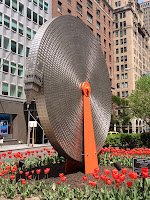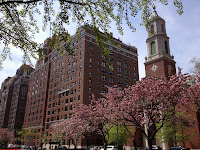Today was another brilliant sunny Sunday morning so we decided to cycle down Park Avenue and take photos of the sculptures and the spring flowers. Last time we walked down Park Avenue, it was covered in snow. Today it was covered in the soft pink and white petals from the pear and cherry trees that line this most beautiful of Avenues. The Japanese community here in NYC is currently marking the two stages of the cherry blossom celebrations – the bloom and the petal carpet that follows.
Park Avenue (formerly Fourth Avenue) is a 140 feet (43 m) wide boulevard that carries north and southbound traffic in the New York City borough of Manhattan.
For most of its length, it runs parallel to Madison Avenue to the west and Lexington Avenue to the east. The flowers and greenery in the median of Park Avenue are maintained by the ‘Fund for Park Avenue’. In Spring the flower beds are planted with tulips. Begonias are the flower of choice for the Fund's gardeners in the Summer because there is no automatic watering system and begonias can cope with the hot sun. And every December, Christmas trees are placed in the median in a tradition that started in 1945 as a memorial to soldiers killed in action.
The road that becomes Park Avenue originates as the Bowery. From Cooper Square at 8th Street to Union Square at 14th Street, it is known as Fourth Avenue, a 70 feet (21 m) – wide road. Above 14th Street, it turns slightly east of north to align with other avenues of the Commissioners' Plan of 1811. From 14th Street to 17th Street, it forms the eastern boundary of Union Square and is known as Union Square East; its southbound lanes merge with Broadway for this distance. From 17th Street to 32nd Street, it is known as Park Avenue South. Above 32nd Street, for the remainder of its distance, it is known as Park Avenue, the famous 140-foot-wide boulevard.
From Grand Central Station on 42nd Street all the way up to 97th Street, the Metro-North Railroad tracks run in a tunnel underneath Park Avenue (the Park Avenue Tunnel). At 97th, the tracks come above ground, rising onto the structure known as the Park Avenue Viaduct. The first street to pass under the viaduct is 102nd Street; from there to the Harlem River the railroad viaduct runs down the middle of Park Avenue.
Park Avenue was originally known as Fourth Avenue and was considered a not very desirable address as, alongside it ran the tracks of the New York and Harlem Railroad on an above ground ‘elevated railway’. When the railroad company’s Grand Central Depot was opened in the 1870s, the railroad tracks between 56th and 96th Streets were sunk out of sight, and, in 1888, Park Avenue was extended to the Harlem River.
This had the effect of more than doubling the width of the Avenue, making it by far the widest roadway in New York. The thick black polluting smoke from the steam locomotives, arising as they necessarily did through the many ventilation shafts in the median of the Avenue, meant that it was still not regarded as a desirable place to live.
But that all changed in 1906 when the railway line was electrified, thus greatly reducing both the noise and the pollution it gave forth. Then, in a master stroke of marketing, the owner of the railway, Mr Cornelius Vanderbilt somehow (?) convinced the then Secretary of State Mr Elihu Root to show his confidence in the effective]ness of the new electrified rail line by constructing a lavish private residence on the corner of Park Avenue and East 71st Street. It was, at the time, the finest mansion New York had ever seen, and immediately after its completion in January 1907 Park Avenue became quite the most fashionable street in the city.
In the 1920s the portion of Park Avenue from Grand Central Terminal to 96th Street saw extensive apartment building construction. This long stretch of the avenue contains some of the most expensive real estate in the world. Real estate at 740 Park Avenue, for example, sells for several thousand dollars per square foot.
Current and former residents in this stretch of the thoroughfare include Blackstone Group co-founder Stephen Schwarzman, former Morgan Stanley executive Zoe Cruz, private equity investor Ronald O. Perelman, John D. Rockefeller Jr., Vera Wang, and others. James Cash Penney lived at 888, and Leonard Bernstein at 898.
Today the median strip which once contained only the ventilation shafts for the railway that runs just below the surface of the avenue has been converted into a series of parks that abound with carefully tended gardens and a series of sculptures by Alexandre Arrechea commissioned by ‘The Sculpture Committee for the Fund for Park Avenue’ and NYC Parks and Recreation’s Public Art Program. These two organisations have been supporting the display of artwork in the median strip parks along Park Avenue since 1967, and this is yet another example of the support of the arts and the provision of works for the people by the people.
After travelling to the end of ‘the beautiful end of Park Avenue’ we turned off at 97th Street and cycled up to 5th Avenue to visit the City of New York Museum. This beautiful old building with a wonderful view of the park houses various exhibitions and a great film highlighting the history of the city.
It explains life in NYC during the various eras including – The Colonial City (1624 – 1783), The Great Port (1783 – 1825), The City of Strangers (1825 – 1865), The Metropolis (1865 – 1900), The Modern City (1900 – 1920), The Cosmopolitan City (1920 – 1945), The Regional city (1945 – 1975) and the Renaissance (1975 – 2001). It was great to see the rollercoaster of resilience that the people of NYC have demonstrated over the years.
There was also an exhibition on the practice of ‘voicing an opinion’. No surprises here as this is something NYC is known for. It was interesting to follow the philosophy and modes of practice of activism by New Yorkers over time involving a range of civil rights issues like religious freedom, immigration, slavery, unionism, equality regarding gender, conservation, the environment, sexuality and even bicycle lanes!
The coolest bit of this museum by far was the Stettheimer Doll House. Carrie Stettheimer (1896–1944) and her sisters Florine and Ettie lived large at Alwyn Court on the Westside of Central Park and when not hosting lavish artistic post WWII gatherings, the three socialites spent their days decorating this huge doll’s house with the elegant and eclectic decor of the 1920s.
The sophisticated style of the artistic and literary avant-garde who frequented their drawing room made for the most amazing ‘little treasure’. I wish I had a doll’s house with interior design contributions from Duchamp, Bellows, Gleizes Lachaise and Zorich!
Something to think about – US Budget cuts have caused compulsory unpaid ‘furloughs’ for air traffic controllers and caused massive disruption to business – pressure was put on and Congress and this problem was fixed in one week. Are guns laws not as (if not more) important?
















No comments:
Post a Comment